Advancements in Complementary Metal-Oxide Semiconductor-Compatible Tunnel Barrier Engineered Charge-Trapping Synaptic Transistors for Bio-Inspired Neural Networks in Harsh Environments
Abstract
:1. Introduction
2. Materials and Methods
2.1. Fabrication of a Silicon-on-Insulator-Based Charge-Trapping Synaptic Transistor with Engineered Tunnel Barriers
2.2. Characterizations
3. Results and Discussion
3.1. Electrical Characteristics of Complementary Metal-Oxide Semiconductor-Compatible Charge-Trapping Synaptic Transistors
3.2. Synaptic Characteristics of CMOS-Compatible Charge-Trapping Synaptic Transistors
3.3. Modified National Institute of Standards and Technology Artificial Neural Network Recognition Simulation of Devices
4. Conclusions
Author Contributions
Funding
Institutional Review Board Statement
Data Availability Statement
Acknowledgments
Conflicts of Interest
References
- Kuzum, D.; Yu, S.; Wong, H.P. Synaptic electronics: Materials, devices, and applications. Nanotechnology 2013, 24, 382001. [Google Scholar] [CrossRef] [PubMed]
- Indiveri, G.; Liu, S.C. Memory and information processing in neuromorphic systems. Proc. IEEE 2015, 103, 1379–1397. [Google Scholar] [CrossRef]
- Wan, Q.; Sharbati, M.T.; Erickson, J.R.; Du, Y.; Xiong, F. Emerging artificial synaptic devices for neuromorphic computing. Adv. Mater. Technol. 2019, 4, 1900037. [Google Scholar] [CrossRef]
- Budiman, F.; Hernowo, D.G.O.; Pandey, R.R.; Tanaka, H. Recent progress on the fabrication of memristor and transistor-based neuromorphic devices for high signal processing speed with low power consumption. Jpn. J. Appl. Phys. 2018, 57, 03EA06. [Google Scholar] [CrossRef]
- Du, H.; Lin, X.; Xu, Z.; Chu, D. Electric double-layer transistors: A review of recent progress. J. Mater. Sci. 2015, 50, 5641–5673. [Google Scholar] [CrossRef]
- He, Y.; Yang, Y.; Nie, S.; Liu, R.; Wan, Q. Electric-double-layer transistors for synaptic devices and neuromorphic systems. J. Mater. Chem. C 2018, 6, 5336–5352. [Google Scholar] [CrossRef]
- Rehman, S.; Khan, M.F.; Rahmani, M.K.; Kim, H.; Patil, H.; Khan, S.A.; Kang, M.H.; Kim, D.-K. Neuro-transistor based on uv-treated charge trapping in mote for artificial synaptic features. Nanomaterials 2020, 10, 2326. [Google Scholar] [CrossRef]
- Du, Y.; Du, L.; Gu, X.; Du, J.; Wang, X.S.; Hu, B.; Jiang, M.; Chen, X.; Iyer, S.; Chang, M.-C.F. An analog neural network computing engine using CMOS-compatible charge-trap-transistor (CTT). IEEE Trans. Comput.-Aided Des. Integr. Circuits Syst. 2018, 38, 1811–1819. [Google Scholar] [CrossRef]
- Park, M.K.; Yoo, H.N.; Seo, Y.T.; Woo, S.Y.; Bae, J.H.; Park, B.G.; Lee, J.H. Field effect transistor-type devices using high-κ gate insulator stacks for neuromorphic applications. ACS Appl. Electron. Mater. 2019, 2, 323–328. [Google Scholar] [CrossRef]
- Shrivastava, S.; Chavan, T.; Ganguly, U. Ultra-low energy charge trap flash-based synapse enabled by parasitic leakage mitigation. arXiv 2019, arXiv:1902.09417. [Google Scholar]
- Dai, M.; Song, Z.; Lin, C.H.; Dong, Y.; Wu, T.; Chu, J. Multi-functional multi-gate one-transistor process-in-memory electronics with foundry processing and footprint reduction. Commun. Mater. 2022, 3, 41. [Google Scholar] [CrossRef]
- Sugizaki, T.; Kobayashi, M.; Ishidao, M.; Minakata, H.; Yamaguchi, M.; Tamura, Y.; Sugiyama, Y.; Nakanishi, T.; Tanaka, H. Novel multi-bit SONOS type flash memory using a high-k charge trapping layer. In Proceedings of the 2003 Symposium on VLSI Technology; Digest of Technical Papers (IEEE Cat. No. 03CH37407), Kyoto, Japan, 10–12 June 2003; IEEE: New York, NY, USA, 2003; pp. 27–28. [Google Scholar] [CrossRef]
- Sun, L.; Pan, L.; Luo, X.; Wu, D.; Zhu, J. Discussion on the CHE programming characteristics with the scaling down of charge trapping flash memory. In Proceedings of the 2006 8th International Conference on Solid-State and Integrated Circuit Technology Proceedings, Shanghai, China, 23–26 October 2006; IEEE: New York, NY, USA, 2006; pp. 824–826. [Google Scholar] [CrossRef]
- Zhao, C.; Zhao, C.Z.; Taylor, S.; Chalker, P.R. Review on non-volatile memory with high-k dielectrics: Flash for generation beyond 32 nm. Materials 2014, 7, 5117–5145. [Google Scholar] [CrossRef] [PubMed]
- Park, S.K. Technology scaling challenge and future prospects of DRAM and NAND flash memory. In Proceedings of the 2015 IEEE International Memory Workshop (IMW), Monterey, CA, USA, 17–20 May 2015; IEEE: New York, NY, USA, 2015; pp. 1–4. [Google Scholar] [CrossRef]
- You, H.W.; Cho, W.J. Charge trapping properties of the HfO2 layer with various thicknesses for charge trap flash memory applications. Appl. Phys. Lett. 2010, 96, 093506. [Google Scholar] [CrossRef]
- Yoo, J.; Kim, S.; Jeon, W.; Park, A.; Choi, D.; Choi, B. A study on the charge trapping characteristics of high-k laminated traps. IEEE Electron. Device Lett. 2019, 40, 1427–1430. [Google Scholar] [CrossRef]
- Congedo, G.; Lamperti, A.; Lamagna, L.; Spiga, S. Stack engineering of TANOS charge-trap flash memory cell using high-k ZrO2 grown by ALD as charge trapping layer. Microelectron. Eng. 2011, 88, 1174–1177. [Google Scholar] [CrossRef]
- Spassov, D.; Paskaleva, A.; Krajewski, T.A.; Guziewicz, E.; Luka, G.; Ivanov, T. Al2O3/HfO2 multilayer high-k dielectric stacks for charge trapping flash memories. Phys. Status Solidi A Appl. Mater. Sci. 2018, 215, 1700854. [Google Scholar] [CrossRef]
- Tsai, P.H.; Chang-Liao, K.S.; Liu, T.C.; Wang, T.K.; Tzeng, P.J.; Lin, C.-H.; Lee, L.; Tsai, M. Charge-trapping-type flash memory device with stacked high-$ k $ charge-trapping layer. IEEE Electron. Device Lett. 2009, 30, 775–777. [Google Scholar] [CrossRef]
- Lee, C.H.; Hur, S.H.; Shin, Y.C.; Choi, J.H.; Park, D.G.; Kim, K. Charge-trapping device structure of SiO2∕SiN∕high-k dielectric Al2O3 for high-density flash memory. Appl. Phys. Lett. 2005, 86, 152908. [Google Scholar] [CrossRef]
- Trinh, T.T.; Ryu, K.; Jang, K.; Lee, W.; Baek, S.; Raja, J.; Yi, J. Improvement in the performance of an InGaZnO thin-film transistor by controlling interface trap densities between the insulator and active layer. Semicond. Sci. Technol. 2011, 26, 085012. [Google Scholar] [CrossRef]
- You, H.W.; Oh, S.M.; Cho, W.J. Thickness dependence of high-k materials on the characteristics of MAHONOS structured charge trap flash memory. Thin Solid Films 2010, 518, 6460–6464. [Google Scholar] [CrossRef]
- Park, G.H.; Jung, M.H.; Kim, K.S.; Chung, H.B.; Cho, W.J. Tunneling barrier engineered charge trap flash memory with ONO and NON tunneling dielectric layers. Curr. Appl. Phys. 2010, 10, e13–e17. [Google Scholar] [CrossRef]
- Chiu, F.C. A review on conduction mechanisms in dielectric films. Adv. Mater. Sci. Eng. 2014, 2014, 578168. [Google Scholar] [CrossRef]
- Park, G.H.; Cho, W.J. Reliability of modified tunneling barriers for high performance nonvolatile charge trap flash memory application. Appl. Phys. Lett. 2010, 96, 043503. [Google Scholar] [CrossRef]
- Veletić, M.; Mesiti, F.; Floor, P.A.; Balasingham, I. Communication theory aspects of synaptic transmission. In Proceedings of the 2015 IEEE International Conference on Communications (ICC), London, UK, 8–12 June 2015; IEEE: New York, NY, USA, 2015; pp. 1116–1121. [Google Scholar] [CrossRef]
- Veletić, M.; Balasingham, I. An information theory of neuro-transmission in multiple-access synaptic channels. IEEE Trans. Commun. 2019, 68, 841–853. [Google Scholar] [CrossRef]
- Noh, J.; Bae, H.; Li, J.; Luo, Y.; Qu, Y.; Park, T.J.; Si, M.; Chen, X.; Charnas, A.R.; Chung, W.; et al. First experimental demonstration of robust HZO/β-Ga₂O₃ ferroelectric field-effect transistors as synaptic devices for artificial intelligence applications in a high-temperature environment. IEEE Trans. Electron. Devices 2021, 68, 2515–2521. [Google Scholar] [CrossRef]
- Zhou, J.; Li, W.; Chen, Y.; Lin, Y.H.; Yi, M.; Li, J.; Qian, Y.; Guo, Y.; Cao, K.; Xie, L.; et al. A monochloro copper phthalocyanine memristor with high-temperature resilience for electronic synapse applications. Adv. Mater. 2021, 33, 2006201. [Google Scholar] [CrossRef]
- Zhao, Y.; Haseena, S.; Ravva, M.K.; Zhang, S.; Li, X.; Jiang, J.; Fu, Y.; Inal, S.; Wang, Q.; Wang, Y.; et al. Side chain engineering enhances the high-temperature resilience and ambient stability of organic synaptic transistors for neuromorphic applications. Nano Energy 2022, 104, 107985. [Google Scholar] [CrossRef]
- Xia, Z.; Kim, D.S.; Lee, J.Y.; Lee, K.H.; Park, Y.K.; Yoo, M.H.; Chung, C. Investigation of charge loss mechanisms in planar and raised STI charge trapping flash memories. In Proceedings of the 2010 International Conference on Simulation of Semiconductor Processes and Devices, Bologna, Italy, 6–8 September 2010; IEEE: New York, NY, USA, 2010; pp. 233–236. [Google Scholar] [CrossRef]
- Oh, C.; Jo, M.; Son, J. All-solid-state synaptic transistors with high-temperature stability using proton pump gating of strongly correlated materials. ACS Appl. Mater. Interfaces 2019, 11, 15733–15740. [Google Scholar] [CrossRef]
- Atkinson, R.C.; Shiffrin, R.M. Human memory: A proposed system and its control processes. Psychol. Learn. Motiv. 1968, 2, 89–195. [Google Scholar] [CrossRef]
- Bi, G.Q.; Poo, M.M. Synaptic modifications in cultured hippocampal neurons: Dependence on spike timing, synaptic strength, and postsynaptic cell type. J. Neurosci. 1998, 18, 10464–10472. [Google Scholar] [CrossRef]
- Zhang, M.; Fan, Z.; Jiang, X.; Zhu, H.; Chen, L.; Xia, Y.; Yin, J.; Liu, X.; Sun, Q.; Zhang, D.W. MoS2-based charge-trapping synaptic device with electrical and optical modulated conductance. Nanophotonics 2020, 9, 2475–2486. [Google Scholar] [CrossRef]
- Seo, Y.T.; Park, M.K.; Bae, J.H.; Park, B.G.; Lee, J.H. Implementation of synaptic device using various high-k gate dielectric stacks. J. Nanosci. Nanotechnol. 2020, 20, 4292–4297. [Google Scholar] [CrossRef] [PubMed]
- Fan, Z.H.; Zhang, M.; Gan, L.R.; Chen, L.; Zhu, H.; Sun, Q.Q.; Zhang, D.W. ReS2 charge trapping synaptic device for face recognition application. Nanoscale Res. Lett. 2020, 15, 2. [Google Scholar] [CrossRef] [PubMed]
- Ievtukh, V.A.; Ulyanov, V.V.; Nazarov, A.N. The charge trapping/emission processes in silicon nanocrystalline nonvolatile memory assisted by electric field and elevated temperatures. Semicond. Phys. Quantum Electron. Optoelectron. 2016, 19, 116–123. [Google Scholar] [CrossRef]
- Tang, Z.; Li, R.; Zhang, X.; Geng, H.; Zang, S.; Zheng, H.; Lian, M.; Hu, N. Correlation between memory characteristics and energy band bending resulted from composition distribution of trapping layer for charge trap memory. Semicond. Sci. Technol. 2018, 33, 125006. [Google Scholar] [CrossRef]
- Bliss, T.V.; Collingridge, G.L. A synaptic model of memory: Long-term potentiation in the hippocampus. Nature 1993, 361, 31–39. [Google Scholar] [CrossRef]
- Ohno, T.; Hasegawa, T.; Tsuruoka, T.; Terabe, K.; Gimzewski, J.K.; Aono, M. Short-term plasticity and long-term potentiation mimicked in single inorganic synapses. Nat. Mater. 2011, 10, 591–595. [Google Scholar] [CrossRef]
- Wang, C.; Li, Y.; Wang, Y.; Xu, X.; Fu, M.; Liu, Y.; Lin, Z.; Ling, H.; Gkoupidenis, P.; Yi, M.; et al. Thin-film transistors for emerging neuromorphic electronics: Fundamentals, materials, and pattern recognition. J. Mater. Chem. 2021, 9, 11464–11483. [Google Scholar] [CrossRef]
- Jang, J.W.; Park, S.; Burr, G.W.; Hwang, H.; Jeong, Y.H. Optimization of conductance change in Pr1–xCaxMnO3-based synaptic devices for neuromorphic systems. IEEE Electron. Device Lett. 2015, 36, 457–459. [Google Scholar] [CrossRef]
- Chen, X.; Li, E.; Zhang, X.; Chen, Q.; Yu, R.; Ye, Y.; Chen, H.; Guo, T. Printed organic synaptic transistor array for one-to-many neural response. IEEE Electron. Device Lett. 2022, 43, 394–397. [Google Scholar] [CrossRef]
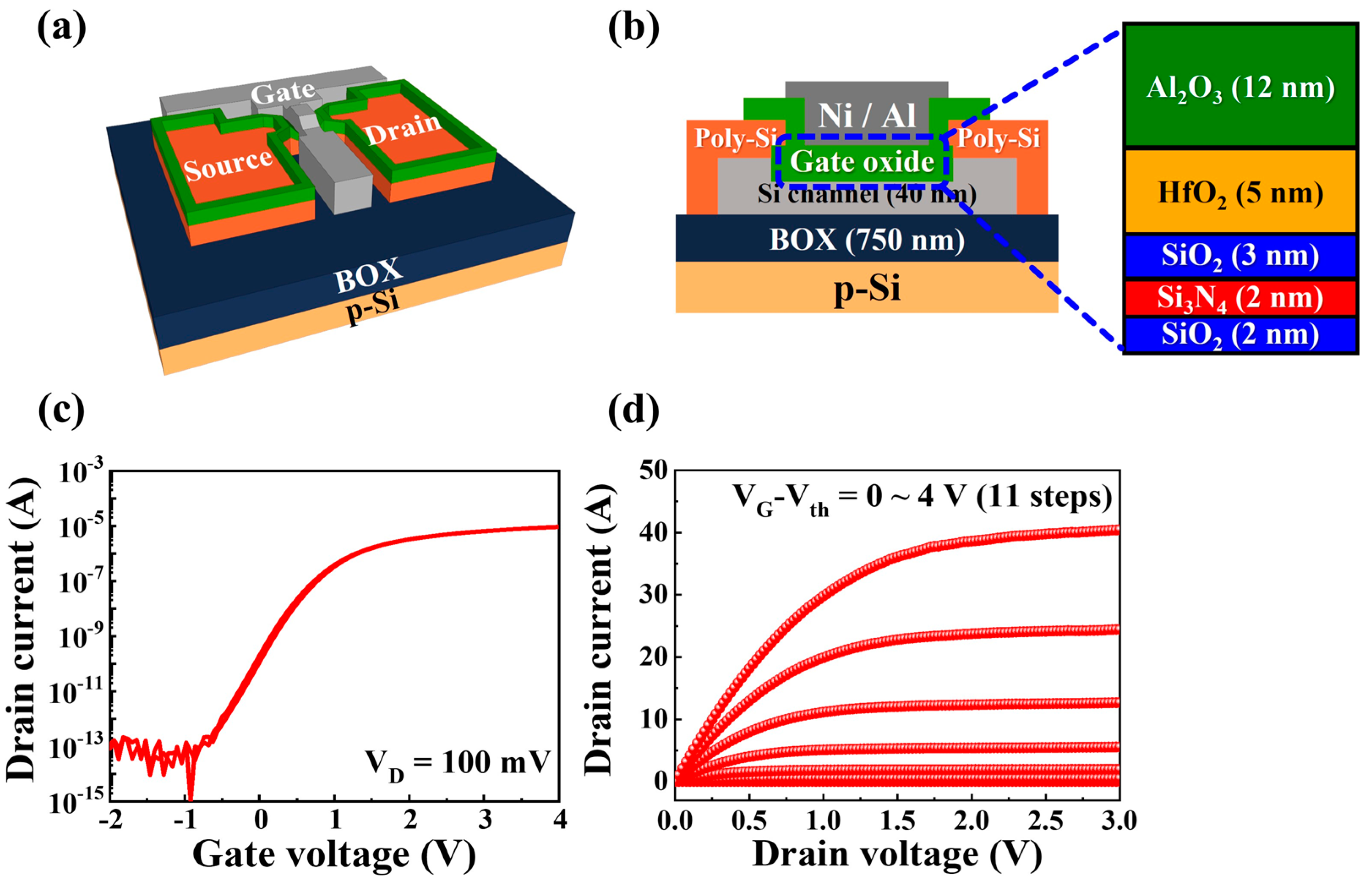
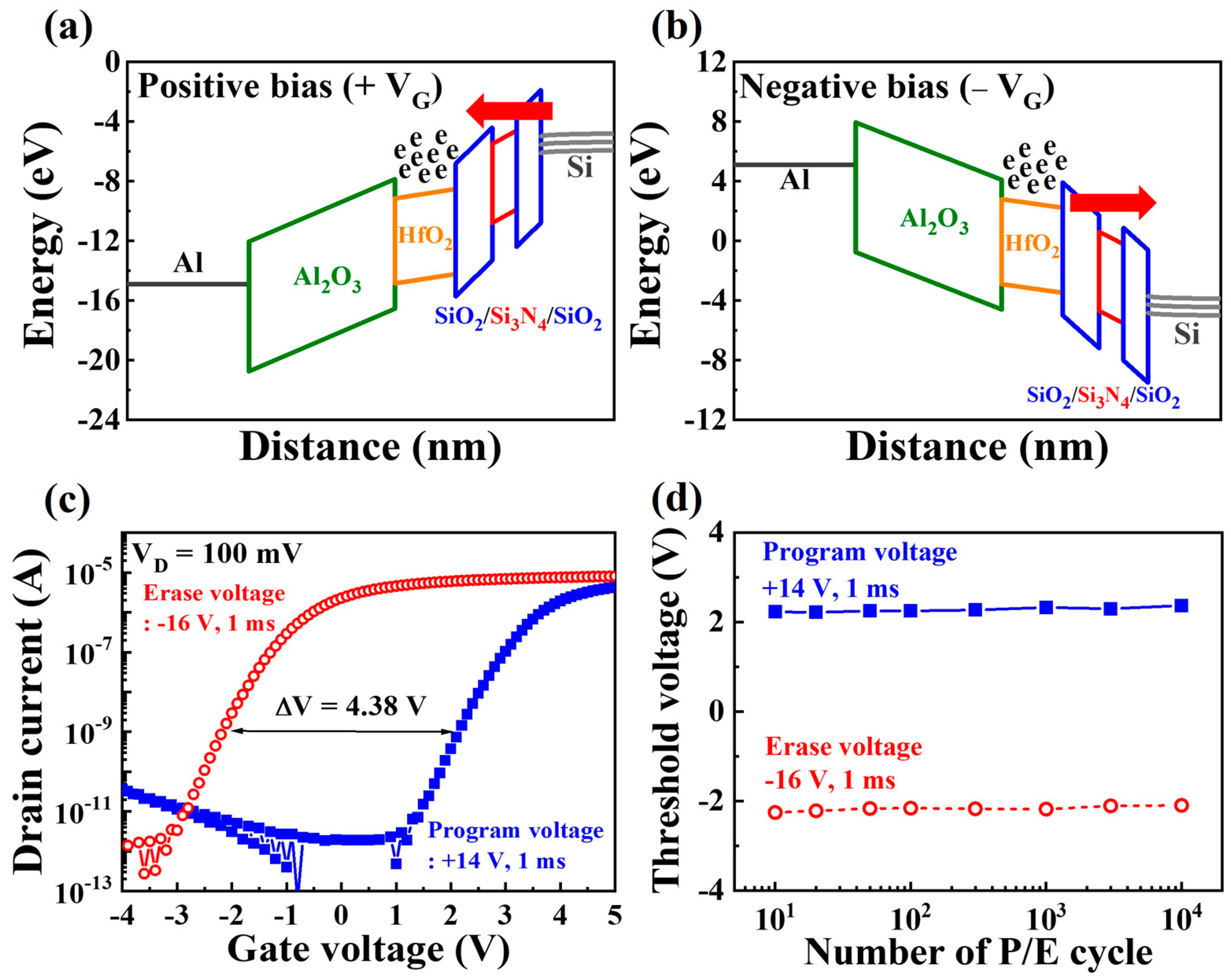

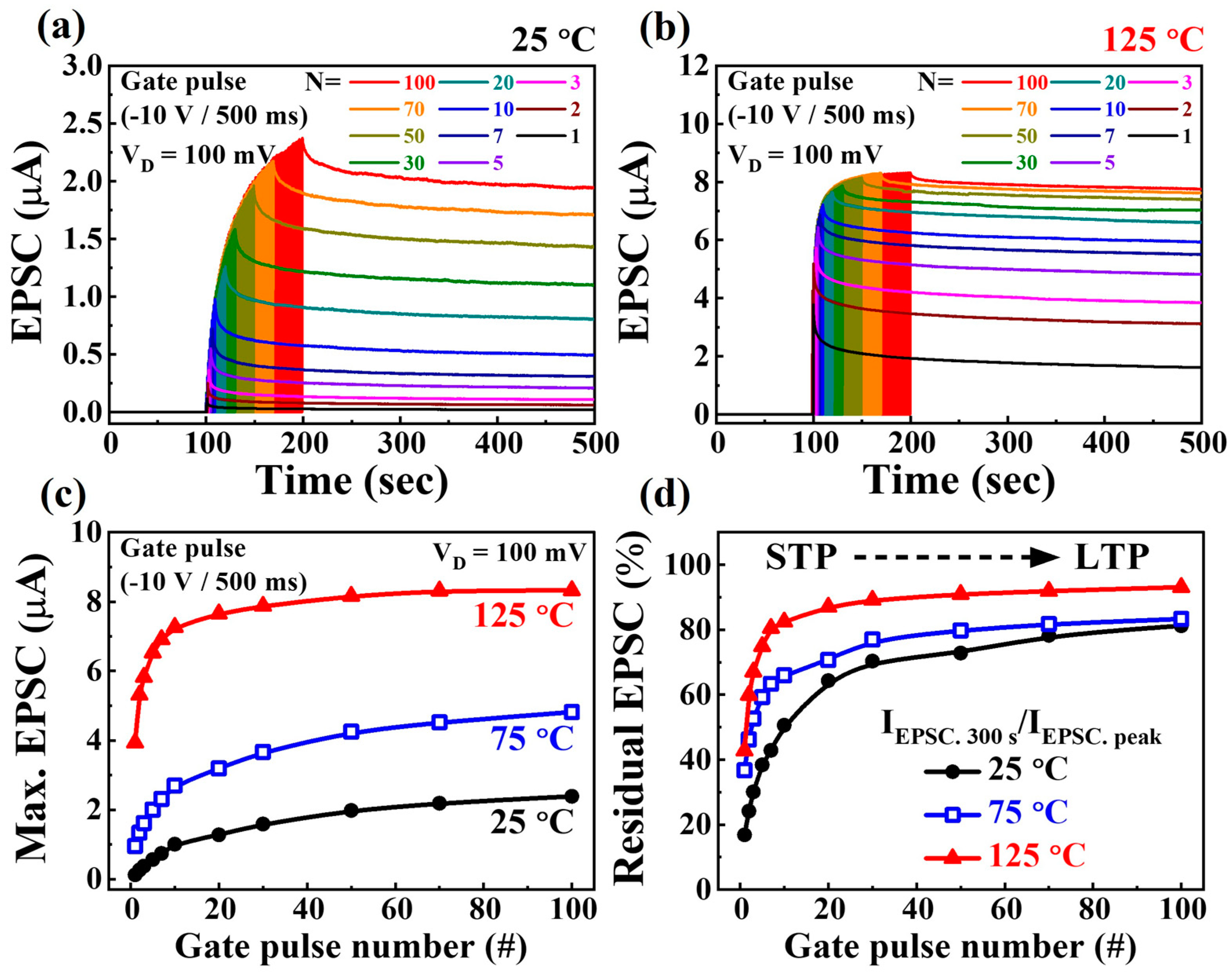

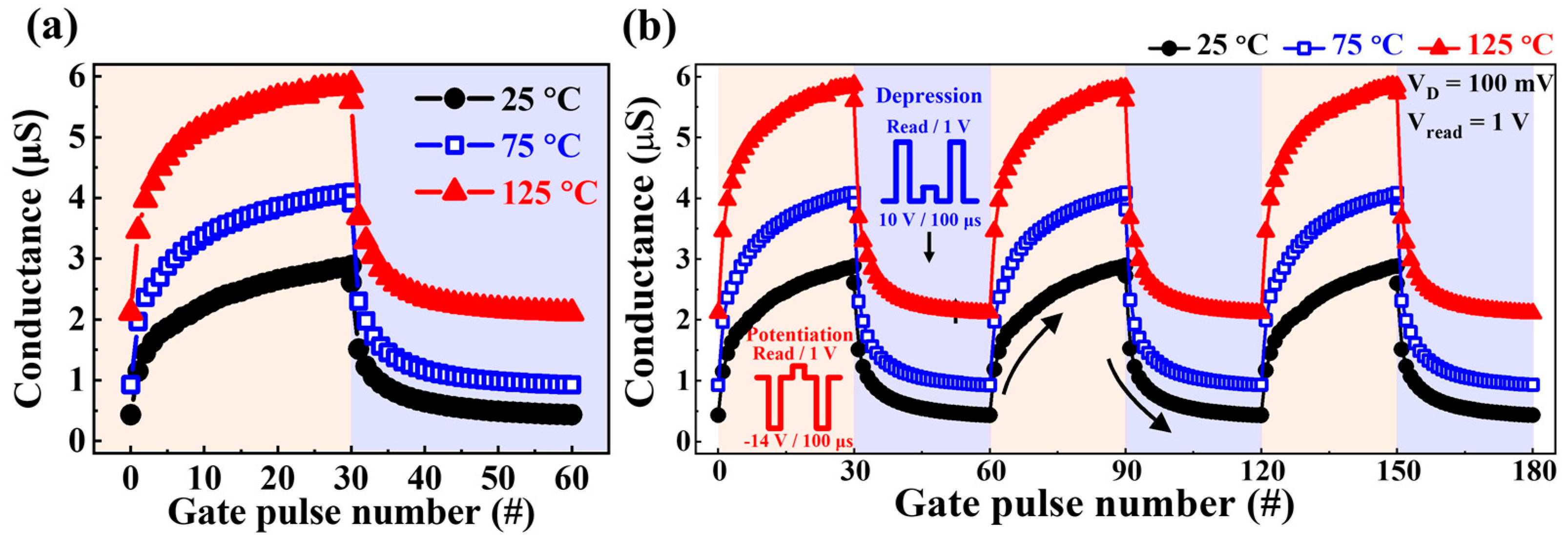
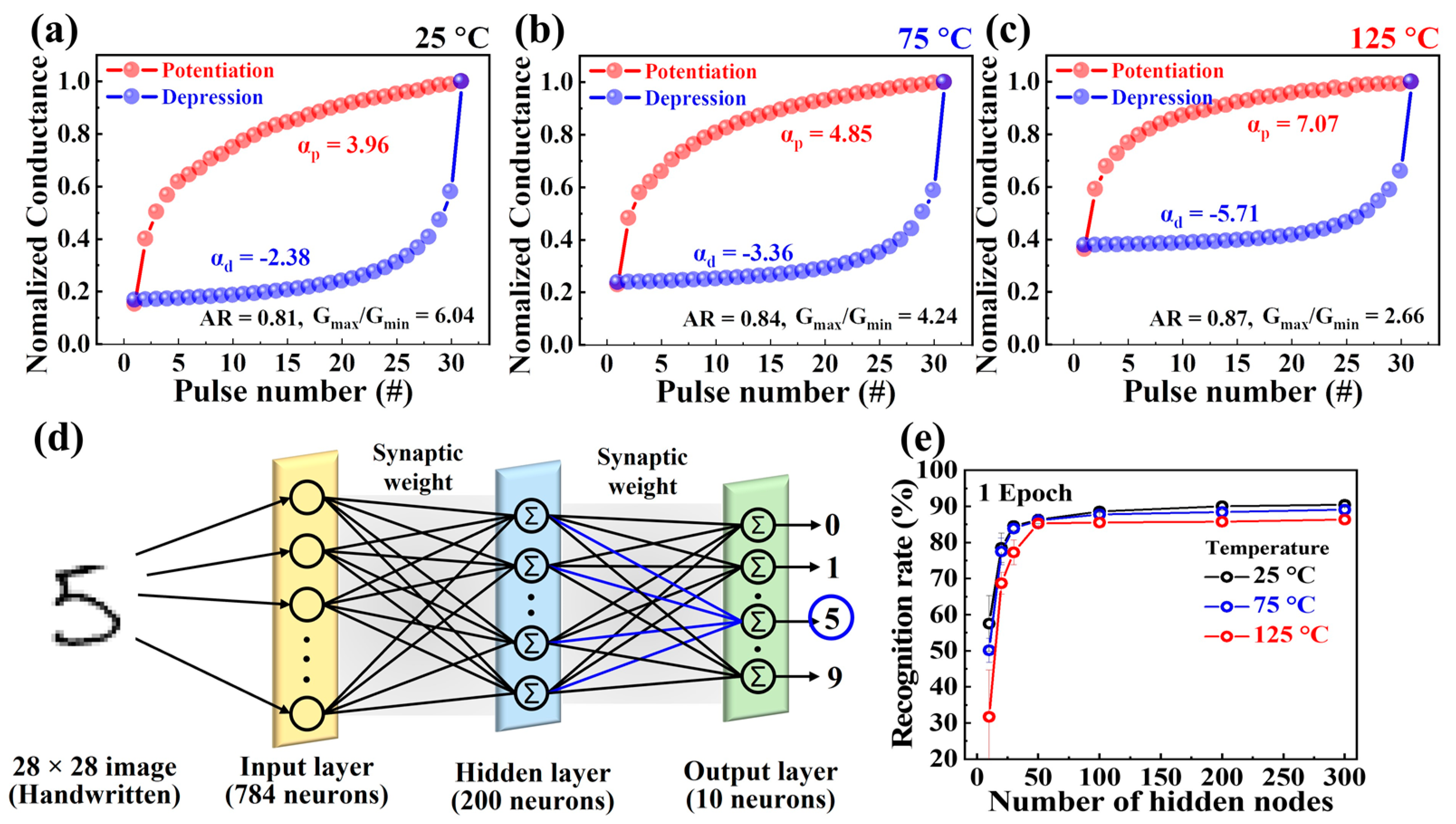
| Total Parameter | |||
|---|---|---|---|
| Vth [V] | On/Off Current Ratio | µFE [cm2/V×s] | SS [mV/dec] |
| −0.09 | 9.35 × 107 | 209.87 | 204.52 |
Disclaimer/Publisher’s Note: The statements, opinions and data contained in all publications are solely those of the individual author(s) and contributor(s) and not of MDPI and/or the editor(s). MDPI and/or the editor(s) disclaim responsibility for any injury to people or property resulting from any ideas, methods, instructions or products referred to in the content. |
© 2023 by the authors. Licensee MDPI, Basel, Switzerland. This article is an open access article distributed under the terms and conditions of the Creative Commons Attribution (CC BY) license (https://creativecommons.org/licenses/by/4.0/).
Share and Cite
Lee, D.-H.; Park, H.; Cho, W.-J. Advancements in Complementary Metal-Oxide Semiconductor-Compatible Tunnel Barrier Engineered Charge-Trapping Synaptic Transistors for Bio-Inspired Neural Networks in Harsh Environments. Biomimetics 2023, 8, 506. https://doi.org/10.3390/biomimetics8060506
Lee D-H, Park H, Cho W-J. Advancements in Complementary Metal-Oxide Semiconductor-Compatible Tunnel Barrier Engineered Charge-Trapping Synaptic Transistors for Bio-Inspired Neural Networks in Harsh Environments. Biomimetics. 2023; 8(6):506. https://doi.org/10.3390/biomimetics8060506
Chicago/Turabian StyleLee, Dong-Hee, Hamin Park, and Won-Ju Cho. 2023. "Advancements in Complementary Metal-Oxide Semiconductor-Compatible Tunnel Barrier Engineered Charge-Trapping Synaptic Transistors for Bio-Inspired Neural Networks in Harsh Environments" Biomimetics 8, no. 6: 506. https://doi.org/10.3390/biomimetics8060506
APA StyleLee, D.-H., Park, H., & Cho, W.-J. (2023). Advancements in Complementary Metal-Oxide Semiconductor-Compatible Tunnel Barrier Engineered Charge-Trapping Synaptic Transistors for Bio-Inspired Neural Networks in Harsh Environments. Biomimetics, 8(6), 506. https://doi.org/10.3390/biomimetics8060506





